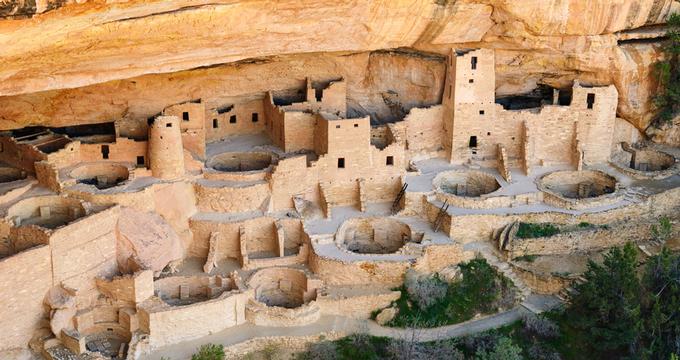One of America’s richest archaeological landscapes, Mesa Verde National Park preserves the ancient dwellings and cultural legacy of the Pueblo people, who inhabited this high plateau for over 700 years beginning around 550 AD. Their innovations—such as sunken kivas, early chimney design, and artistic pottery—offer a window into a remarkably advanced civilization. Established in 1906 and named for its “green table” of forested mesas, Mesa Verde stands today as a protected National Park and a designated UNESCO World Heritage Site.
Recommended For
Mesa Verde National Park is ideal for:
- History buffs eager to explore ancient civilizations and cliff dwellings.
- Outdoor enthusiasts interested in hiking, nature, and panoramic mesa views.
- Photographers looking to capture sunlit ruins and sweeping landscapes.
- Families and students seeking immersive, hands-on education in archaeology and conservation.
- Writers and artists participating in residency programs in a truly inspiring setting.
What Is Mesa Verde?
- Mesa: A flat-topped elevation with steep sides—Mesa Verde is named for its juniper- and piñon-covered “green table.”
- Pueblo people: The park preserves the homes and sacred sites of over 26 cultural groups that formed a vibrant and complex society.
- Farming culture: The Pueblo people grew corn, beans, and squash and lived in sunken and cliff-side dwellings.
Archaeological Significance
- Notable Sites: Includes Cliff Palace, Balcony House, Square Tower House, Sixteen Window House, and Spruce Tree House (currently closed).
- Richard Wetherill & Charles Mason: Documented over 182 cliff dwellings in the 1880s.
- Gustaf Nordensköld: A Swedish mineralogist and the first scientist to study the site in depth in 1891.
- UNESCO Site: Mesa Verde was officially designated in 1978.
Visitor Highlights
- Chapin Mesa Archaeological Museum: Learn about daily life, explore artifacts, and view informative exhibits and films.
- Visitor and Research Center: Refurbished in 2012, it serves as the park’s hub for orientation and ticketing.
- Ranger-led tours: Available for Cliff Palace, Balcony House, and Long House—advance ticketing required.
Preservation Efforts
- In 1906, President Roosevelt signed the bill making Mesa Verde a National Park—protecting its structures and cultural artifacts.
- The Wetherill Mesa Archaeological Project combines science and education to preserve key sites.
- During the Great Depression, New Deal programs built roads, trails, and infrastructure.
- A respectful reburial ceremony was held in 2006 to commemorate the park’s centennial.
Activities and Programs
- Hiking trails: Explore ruins and scenic viewpoints across the mesa top.
- Evening programs: Includes twilight photography classes and fireside storytelling.
- Winter activities: Cross-country skiing and snowshoeing offer a serene, snow-covered park experience.
- Artists & writers residencies: Foster creative reflection in an inspiring archaeological setting.
Planning Your Visit
- Location: Mesa Verde National Park, Colorado
- Website: nps.gov/meve
- Open year-round: Operating hours vary by season—check schedules in advance.
- Entrance fees: Free entry offered on 10 special days throughout the year.
- Accommodations: Choose from Far View Lodge, camping facilities, and four dining locations.
Safety Tips
- Altitude: Trails often exceed 7,000 feet—be prepared for steep, high-elevation hiking.
- Driving: Roads include sharp turns and steep drops; drive carefully and obey posted limits.
- Weather: Be alert for lightning storms and temperature changes; seek shelter in a vehicle or building when necessary.
- Wildlife: Respect all animals and remain alert on trails.
- Cycling: Permitted only on designated roads; no dedicated bike paths available.
Learn more about Mesa Verde National Park
Plan Your Trip


